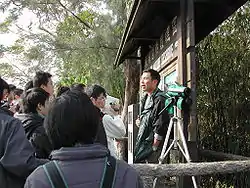Mai Po Marshes
Mai Po Marshes (Chinese: 米埔濕地; Hong Kong Hakka: Mi3bu4 Sip5ti4) is a nature reserve located in San Tin[2] near Yuen Long in Hong Kong. It is part of Deep Bay, an internationally significant wetland that is actually a shallow estuary, at the mouths of Sham Chun River, Shan Pui River (Yuen Long Creek) and Tin Shui Wai Nullah. Inner Deep Bay is listed as a Ramsar site under Ramsar Convention in 1995, and supports globally important numbers of wetland birds, which chiefly arrive in winter and during spring and autumn migrations. The education center and natural conservation area is 380 acres (1.5 km2) wide and its surrounding wetland has an area of 1500 acres (6 km2). It provides a conservation area for mammals, reptiles, insects, and over 350 species of birds.
| Mai Po Marshes | |
|---|---|
 Fish pond in Mai Po | |
 Map of Hong Kong | |
| Location | San Tin, Hong Kong |
| Nearest city | Yuen Long |
| Coordinates | 22°29′56″N 114°02′45″E |
| wwf | |
| Official name | Mai Po Marshes and Inner Deep Bay |
| Designated | 4 September 1995 |
| Reference no. | 750[1] |
| Mai Po Marshes | |||||||||||||||
|---|---|---|---|---|---|---|---|---|---|---|---|---|---|---|---|
| Traditional Chinese | 米埔濕地 | ||||||||||||||
| Simplified Chinese | 米埔湿地 | ||||||||||||||
| |||||||||||||||




The reserve is managed by the World Wide Fund for Nature Hong Kong since 1983 and WWF runs professionally guided visits for the public and schools to the reserve ; the Agriculture, Fisheries and Conservation Department has responsibilities for the Ramsar site as a whole. Deep Bay faces threats, including pollution, and rising mudflat levels that perhaps arise from intense urbanization, especially (in recent years) on the north, Shenzhen side of the bay.
In recent years, it housed over 55,000 migrating birds, including Saunders's gull (Chroicocephalus saundersi) and a quarter of the world's black-faced spoonbill (Platalea minor) population. It also has inter-tidal mangroves along with 24 traditionally operated shrimp ponds (called Gei Wai locally) to provide food for the birds. Mai Po Marshes receives some 32,000 visitors annually. This April 2020 a pair of spoonbill sandpiper have been spotted at the reserve.
While the area was taken out of the Frontier Closed Area on 15 February 2012, Mai Po Nature Reserve remains a restricted area under the Wild Animals Protection Ordinance (Chapter 170) in order to minimize disturbance to wildlife.
Visitors need a 'Mai Po Marshes Entry Permit' to enter the Reserve. By joining a WWF professionally guided activity you can book online wwf.org.hk/en and be part of a small group ecovisit and WWF will take care of permits for you. ( From 16 March - small eco groups of 4 will ensure community health precautions to maintain safe , healthy access on your visit with WWF to the Reserve )
Individuals can apply for a permit by writing to the Agriculture, Fisheries & Conservation Department of Hong Kong Government. The aforementioned Individual Permits normally take about four weeks to be processed.
The marshes are also have rich insect biodiversity, being the place the endemic Mai Po bent winged firefly (Pteroptyx maipo Ballantyne) was discovered.[3] Not only was the species new to science, but it was also the first time for the genus Pteroptyx has been recorded in China. To understand the seasonal population changes, distribution and habitat requirements of the species, WWF Hong Kong have been carrying out firefly surveys of the nature reserve.[4] The surveys have also incorporated Citizen Science participation,[5] and using this approach to further monitor the biodiversity, WWF have incorporated iNaturalist and the City Nature Challenge into activities at their Mai Po centre.[6]
Avian flu outbreak
In February 2008, the Hong Kong government closed Mai Po for 21 days following the discovery of a great egret infected with H5N1, also known as avian flu. The closing marked the fourth in as many years and was consistent with the government's policy of closing Mai Po whenever an infection is discovered within a 3 kilometer radius of the premises.
The World Wide Fund for Nature criticized the government, however, for what it called a discrepancy between the standards for closing Mai Po and the comparably less strict standards applied in urban areas. The World Wide Fund for Nature wanted compensation of 1 million Hong Kong dollars.[7] WWF then claimed that the government had not compensated it for lost income.

See also
References
- "Mai Po Marshes and Inner Deep Bay". Ramsar Sites Information Service. Retrieved 25 April 2018.
- "2015 District Councils Election - Summary of the District Council Constituency Areas". Hong Kong Government.
- Yiu, Vor; Cheng, Chui-Yu; Shih, Chun-Hat; Fu, Xin Hua; Ballantyne, Lesley (2011-06-27). "Pteroptyx maipo Ballantyne, a new species of bent-winged firefly (Coleoptera: Lampyridae) from Hong Kong, and its relevance to firefly biology and conservation". Zootaxa. 2931 (1): 8–34. doi:10.11646/zootaxa.2931.1.2. ISSN 1175-5334.
- "Firefly survey at the Mai Po Nature Reserve | WWF Hong Kong". www.wwf.org.hk. Retrieved 2019-06-25.
- Ip, Alex (2018-07-30). "Fireflies (Sort of) Like Lights - The CitizenScience.Asia Journal". Medium. Retrieved 2019-06-25.
- "City Nature Challenge | WWF Hong Kong". www.wwf.org.hk. Retrieved 2019-06-25.
- Lam, Agnes (2008-02-27). "South China Morning Post: Mai Po wants review of bird-flu shutdowns WWF seeks HK$1m for closure of reserve". South China Morning Post.
Further reading
- Lai, Lawrence W.C.; Lam, Ken K.H.; Lorne, F.T.; Wong, S.K. (2008). "Chapter 12. Economics of Gei Wa Shrimp Culture in Hong Kong: From Commercial Aquaculture to Bird Production". In Leung, Ping Sun; Engle, Carole R. (eds.). Shrimp Culture: Economics, Market, and Trade. John Wiley & Sons. pp. 167–186. ISBN 9780470276563.
External links
| Wikimedia Commons has media related to Mai Po Marshes. |